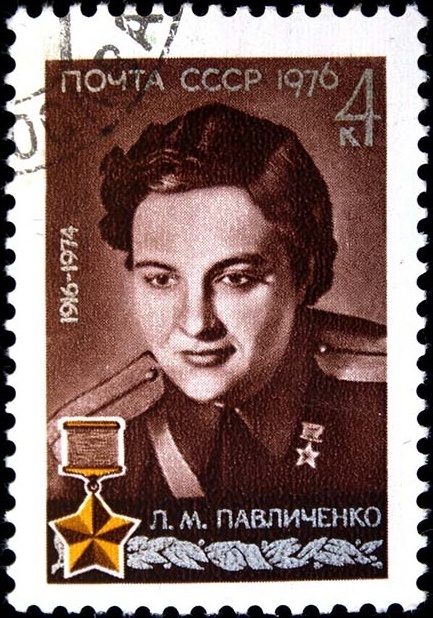Lyudmila Pavlichenko or “Lady Death”
How many people do you have to kill to get featured on, not one but two, stamps? The answer can be found below.
Born in 1916 in a small town in the Ukraine she was an strong willed girl. Her family moved to Kiev in 1930 and she worked as a grinder in a munitions factory while studying history in college. Known as a tomboy she was active in sports including pole vaulting.
Upon hearing a neighborhood boy boasting of his abilities with a gun she took up the challenge and began practicing.
“I set out to show a girl could do as well. So I practiced a lot,” she said, “They wouldn’t take girls in the army so I had to resort to all kinds of tricks to get in.”
Joining the army she soon earned her marksman certification but, because she was a female, no one took her seriously. She was very persistent in asking for a chance do finally her superiors gave her a chance. She was taken to the front and handed a rifle. She was told to try and hit two Romanians working downrange with the Germans. She did so easily.
She was then sent out to the Moldovan and Greek fronts where she had an incredible 187 confirmed German kills in her first 75 days in live combat. She was transferred to Sebastopol where she was pitted against German snipers where she managed to take out 36 of them. After a long 8 months in battle she was hit by shrapnel in the face and sent to a hospital to recover.
She was feared by the Nazis who would broadcast appeals to her to defect to their side. She returned to the Red Army as a sniper trainer. She was credited with 309 confirmed kills although her actual number may be higher since the 309 number reflects those kills witnessed by a third party. She was nicknamed “Lady Death”
The Soviet Union wished the US to enter the war and take the pressure off them. Pavlichenko visited with President Franklin Roosevelt, becoming the first Soviet citizen to be welcomed at the White House. She was only 25 and had been wounded 4 times.
The press asked her questions about what length skirt she wore into battle and her makeup. “There is no rule against it,” Pavlichenko said, “but who has time to think of her shiny nose when a battle is going on?”. One newspapers reported that she “wore no lip rouge, or makeup of any kind,” and that “there isn’t much style to her olive-green uniform.” Another reporter criticized the long length of her uniform skirt, implying that it made her look fat.


She would later say, “I wear my uniform with honor, it has the Order of Lenin on it. It has been covered with blood in battle. It is plain to see that with American women what is important is whether they wear silk underwear under their uniforms. What the uniform stands for, they have yet to learn.”
The Washington Post wrote, “Isn’t it a part of military philosophy that an efficient warrior takes pride in his appearance? Isn’t Joan of Arc always pictured in beautiful and shining armor?”
They did not take her, or woman in the military seriously although she was only one of the 500 snipers out of 2400 that had survived. The lady assassin stuck to her guns (no pun intended) and told America stories of her battles and the invasion of her country. She got her point across that women were both capable and necessary in battle.
She would tell a reporter, “Every German who remains alive will kill women, children and old folks,” she said.“Dead Germans are harmless. Therefore, if I kill a German, I am saving lives.”
She would tell American women, “Now I am looked upon a little as a curiosity,” she said, “a subject for newspaper headlines, for anecdotes. In the Soviet Union I am looked upon as a citizen, as a fighter, as a soldier for my country.”


Pavlichenko would continue her tour in the UK before returning to Kiev to continue her studies. During her tour of America, Pavlichenko and Eleanor Roosevelt became great friends. In 1957, during the cold war. Eleanor Roosevelt pressed her soviet watcher to allow her to visit Pavlichenko. She was eventually allowed to and found her living in a small, two room apartment in Moscow. Being watched they talked in generalities until Pavlichenko grabbed Eleanor by the arm and closed the bedroom door.


She hugged Eleanor “half-laughing, half-crying, telling her how happy she was to see her.” They recounted stories of her visit and the many people she had met.
The stamps show recount her bravery and kill record as a sniper but Lyudmila Pavlichenko was a woman who fought for gender rights and equality as well.



